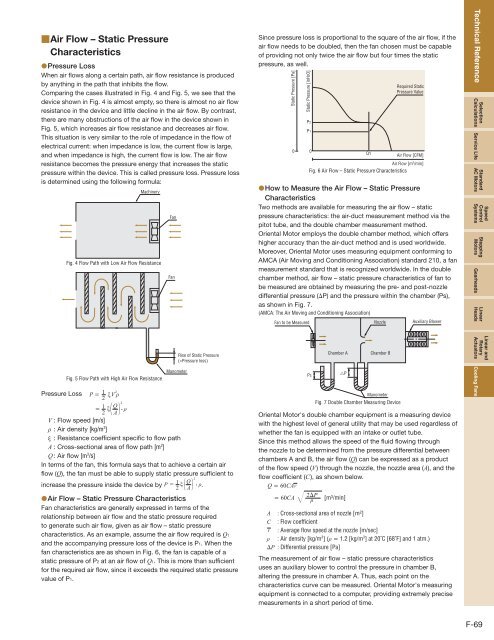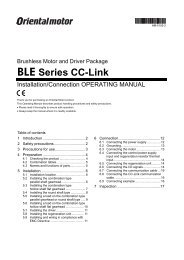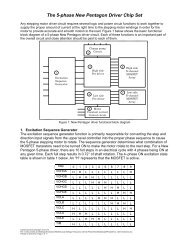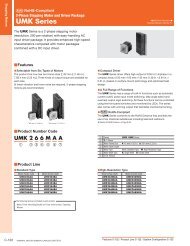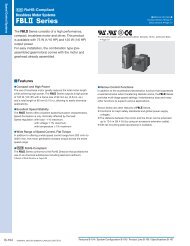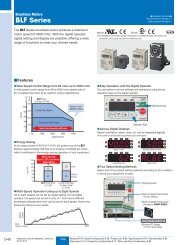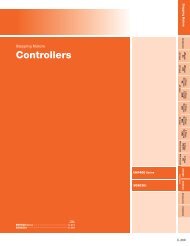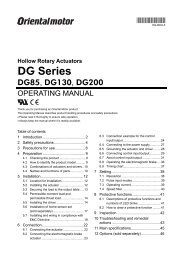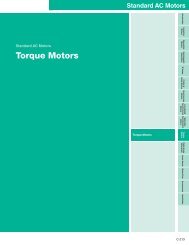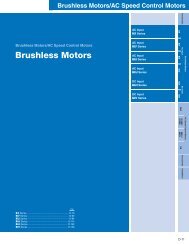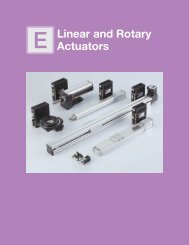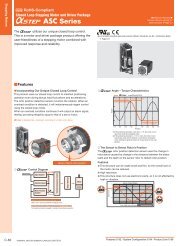Product Reference - Oriental Motor
Product Reference - Oriental Motor
Product Reference - Oriental Motor
Create successful ePaper yourself
Turn your PDF publications into a flip-book with our unique Google optimized e-Paper software.
■Air Flow – Static Pressure<br />
Characteristics<br />
●Pressure Loss<br />
When air flows along a certain path, air flow resistance is produced<br />
by anything in the path that inhibits the flow.<br />
Comparing the cases illustrated in Fig. 4 and Fig. 5, we see that the<br />
device shown in Fig. 4 is almost empty, so there is almost no air flow<br />
resistance in the device and little decline in the air flow. By contrast,<br />
there are many obstructions of the air flow in the device shown in<br />
Fig. 5, which increases air flow resistance and decreases air flow.<br />
This situation is very similar to the role of impedance in the flow of<br />
electrical current: when impedance is low, the current flow is large,<br />
and when impedance is high, the current flow is low. The air flow<br />
resistance becomes the pressure energy that increases the static<br />
pressure within the device. This is called pressure loss. Pressure loss<br />
is determined using the following formula:<br />
Machinery<br />
Fig. 4 Flow Path with Low Air Flow Resistance<br />
Fan<br />
Fan<br />
Since pressure loss is proportional to the square of the air flow, if the<br />
air flow needs to be doubled, then the fan chosen must be capable<br />
of providing not only twice the air flow but four times the static<br />
pressure, as well.<br />
Static Pressure [Pa]<br />
0<br />
Static Pressure [inH2O]<br />
P2<br />
P1<br />
Required Static<br />
Pressure Value<br />
0<br />
Q1<br />
Air Flow [CFM]<br />
Air Flow [m 3 /min]<br />
Fig. 6 Air Flow – Static Pressure Characteristics<br />
●How to Measure the Air Flow – Static Pressure<br />
Characteristics<br />
Two methods are available for measuring the air flow – static<br />
pressure characteristics: the air-duct measurement method via the<br />
pitot tube, and the double chamber measurement method.<br />
<strong>Oriental</strong> <strong>Motor</strong> employs the double chamber method, which offers<br />
higher accuracy than the air-duct method and is used worldwide.<br />
Moreover, <strong>Oriental</strong> <strong>Motor</strong> uses measuring equipment conforming to<br />
AMCA (Air Moving and Conditioning Association) standard 210, a fan<br />
measurement standard that is recognized worldwide. In the double<br />
chamber method, air flow – static pressure characteristics of fan to<br />
be measured are obtained by measuring the pre- and post-nozzle<br />
differential pressure (ΔP) and the pressure within the chamber (Ps),<br />
as shown in Fig. 7.<br />
(AMCA: The Air Moving and Conditioning Association)<br />
Fan to be Measured Nozzle Auxiliary Blower<br />
Technical <strong>Reference</strong><br />
Selection<br />
Calculations Service Life<br />
Standard<br />
AC <strong>Motor</strong>s<br />
Speed<br />
Control<br />
Systems<br />
Stepping<br />
<strong>Motor</strong>s Gearheads<br />
Linear<br />
Heads<br />
Fig. 5 Flow Path with High Air Flow Resistance<br />
Rise of Static Pressure<br />
(=Pressure loss)<br />
Manometer<br />
Pressure Loss P = 1 2<br />
ξV ρ<br />
2<br />
= 1 2<br />
ξ<br />
Q<br />
2 A<br />
· ρ<br />
V : Flow speed [m/s]<br />
ρ : Air density [kg/m 3 ]<br />
ξ : Resistance coefficient specific to flow path<br />
A : Cross-sectional area of flow path [m 2 ]<br />
Q : Air flow [m 3 /s]<br />
In terms of the fan, this formula says that to achieve a certain air<br />
flow (Q), the fan must be able to supply static pressure sufficient to<br />
increase the pressure inside the device by P = 1 2<br />
ξ<br />
Q<br />
2 A<br />
· ρ.<br />
●Air Flow – Static Pressure Characteristics<br />
Fan characteristics are generally expressed in terms of the<br />
relationship between air flow and the static pressure required<br />
to generate such air flow, given as air flow – static pressure<br />
characteristics. As an example, assume the air flow required is Q1<br />
and the accompanying pressure loss of the device is P1. When the<br />
fan characteristics are as shown in Fig. 6, the fan is capable of a<br />
static pressure of P2 at an air flow of Q1. This is more than sufficient<br />
for the required air flow, since it exceeds the required static pressure<br />
value of P1.<br />
PS<br />
Chamber A<br />
△P<br />
Chamber B<br />
Manometer<br />
Fig. 7 Double Chamber Measuring Device<br />
<strong>Oriental</strong> <strong>Motor</strong>'s double chamber equipment is a measuring device<br />
with the highest level of general utility that may be used regardless of<br />
whether the fan is equipped with an intake or outlet tube.<br />
Since this method allows the speed of the fluid flowing through<br />
the nozzle to be determined from the pressure differential between<br />
chambers A and B, the air flow (Q) can be expressed as a product<br />
of the flow speed (V) through the nozzle, the nozzle area (A), and the<br />
flow coefficient (C), as shown below.<br />
Q = 60CAV<br />
= 60CA<br />
2ΔP<br />
ρ<br />
[m3 /min]<br />
A : Cross-sectional area of nozzle [m 2 ]<br />
C : Flow coefficient<br />
V : Average flow speed at the nozzle [m/sec]<br />
ρ : Air density [kg/m 3 ] (ρ = 1.2 [kg/m 3 ] at 20˚C [68˚F] and 1 atm.)<br />
ΔP : Differential pressure [Pa]<br />
The measurement of air flow – static pressure characteristics<br />
uses an auxiliary blower to control the pressure in chamber B,<br />
altering the pressure in chamber A. Thus, each point on the<br />
characteristics curve can be measured. <strong>Oriental</strong> <strong>Motor</strong>'s measuring<br />
equipment is connected to a computer, providing extremely precise<br />
measurements in a short period of time.<br />
Linear and<br />
Rotary<br />
Actuators Cooling Fans<br />
F-69


